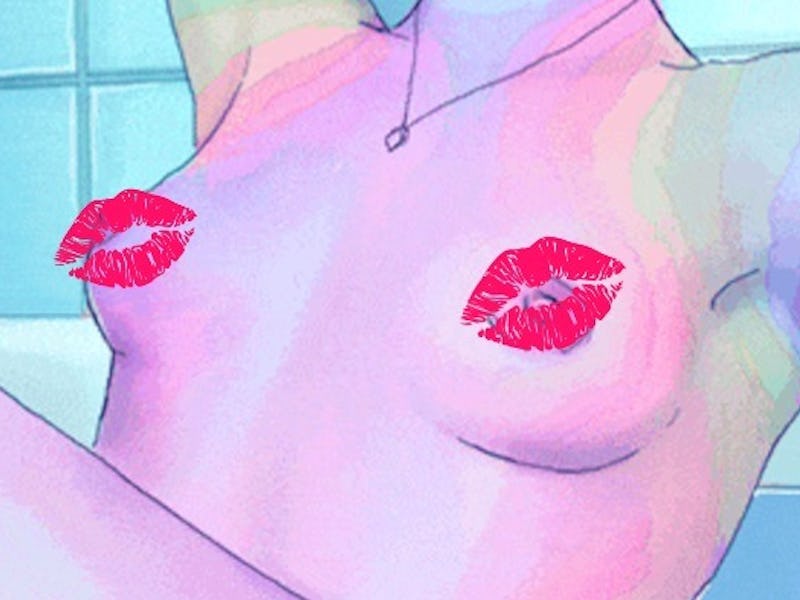
A new viral makeup trend has given people an excuse to spend more time checking out boobs. As the physician-hosts of the talk show The Doctors explained in a recent episode, the best way for a person to find the shade of nude lipstick that will perfectly match their skin tone is to look at the color of their nipples. Since then, fashion publications from Marie Claire to Allure have tested the theory and been surprised with the results: Wearing your nipple color on your lips really can be super attractive!
But perhaps it shouldn’t be all that surprising. Research in evolutionary psychology suggests that part of the reason nipples are so attractive is because they are darker-hued.
Of course, what “attractive” means is open to interpretation, and rating the attractiveness of lip color is mostly a subjective endeavor. (“Now when I wear it, he asks if I have on the ‘nipple’ lipstick, which is ‘so hot,’” one Refinery 29 tester said.) But the contrast a dark areola creates against a lighter-hued breast is certainly eye-catching. And what is the point of lipstick but to draw the attention of human eyes?
There are two broad theories explaining why the areolae are a different color than the rest of the body. One argues that they draw a bull’s-eye around the nipple so that newborn babies don’t have a hard time figuring out where to suck. The other suggests that it’s a sexual signal to potential mates that the nipple-bearer is fertile and ready to bone.
In a post on MadSci in 2001, University of Wisconsin-La Crosse biologist Thomas M. Greiner, Ph.D., acknowledged the plausibility of the baby bull’s-eye theory but pointed out that other mammals who don’t have dark areolae have no problem feeding their kids. In 2009, a study in Communicative and Integrative Biology pointed out that the smell that emanates from a mother’s nipple area was just as useful for beckoning a baby to its milk source.
The more compelling argument is the mate bull’s-eye theory, which suggests that high-contrast nipples are basically the female body’s equivalent of Las Vegas-style neon signage, advertising fertility and the potential for sexual pleasure. In 2010, in the Archives of Sexual Behavior, New Zealand researchers reported that when they tracked male eyeballs as they scanned over images of breasts, “the majority of initial fixations during eye-tracking tests were on the areolae.” Interestingly, they’d hypothesized that men would rate lighter-pigmented areolae as more attractive (“indicative of youth and nubility”), but surveys of the participants revealed that they were more attracted to dark areolae. Since human areolae tend to get darker after pregnancy, they could be interpreted as a signal of past (and future) reproductive success.
It’s possible that the high-contrast nipple zone doesn’t just signal fertility, but it also invites potential mates to straight-up touch them. Most of the time, sexual partners don’t latch onto nipples in order to suck out food, but touching them with a tongue or fingertips does pleasure the nipple owner, which in turn could have positive effects on everyone involved. As a 2011 article in the Journal of Sexual Medicine pointed out, in addition to being great food sources, nipples are packed with nerve endings that, when stimulated, activate the same arousal centers as clitoral and vaginal stimulation (the “genital sensory cortex”). When it comes to sex, arousal is good; but facilitated arousal is great.
In his post, Greiner noted that “visual signals for sexual receptivity and reproductive success are common among animals,” and that it was odd that human females seemed to have “no obvious signal for reproductive success or sexual receptivity.” Dark-colored nipples, he speculated, might be the signal we’ve long overlooked.
Scientists have theorized that our lips are red for similar sex-related reasons. The lips, packed with blood vessels, are red, and research has shown that humans are attracted to the color red on lips. The explanation, as Nicolas Guéguen put it in the International Journal of Psychological Studies, is that bright red lips provide the starkest, most eye-catching contrast between the mouth and the face.
So far, scientists have not compared the attractiveness of a red-lipped mouth versus a nipple-colored lip, but it’s likely that a similar explanation underlies the reason they are considered attractive. Ultimately, the idea is simple: For all our sexual prowess, humans can’t kiss a lip — or nipple — we can’t see.